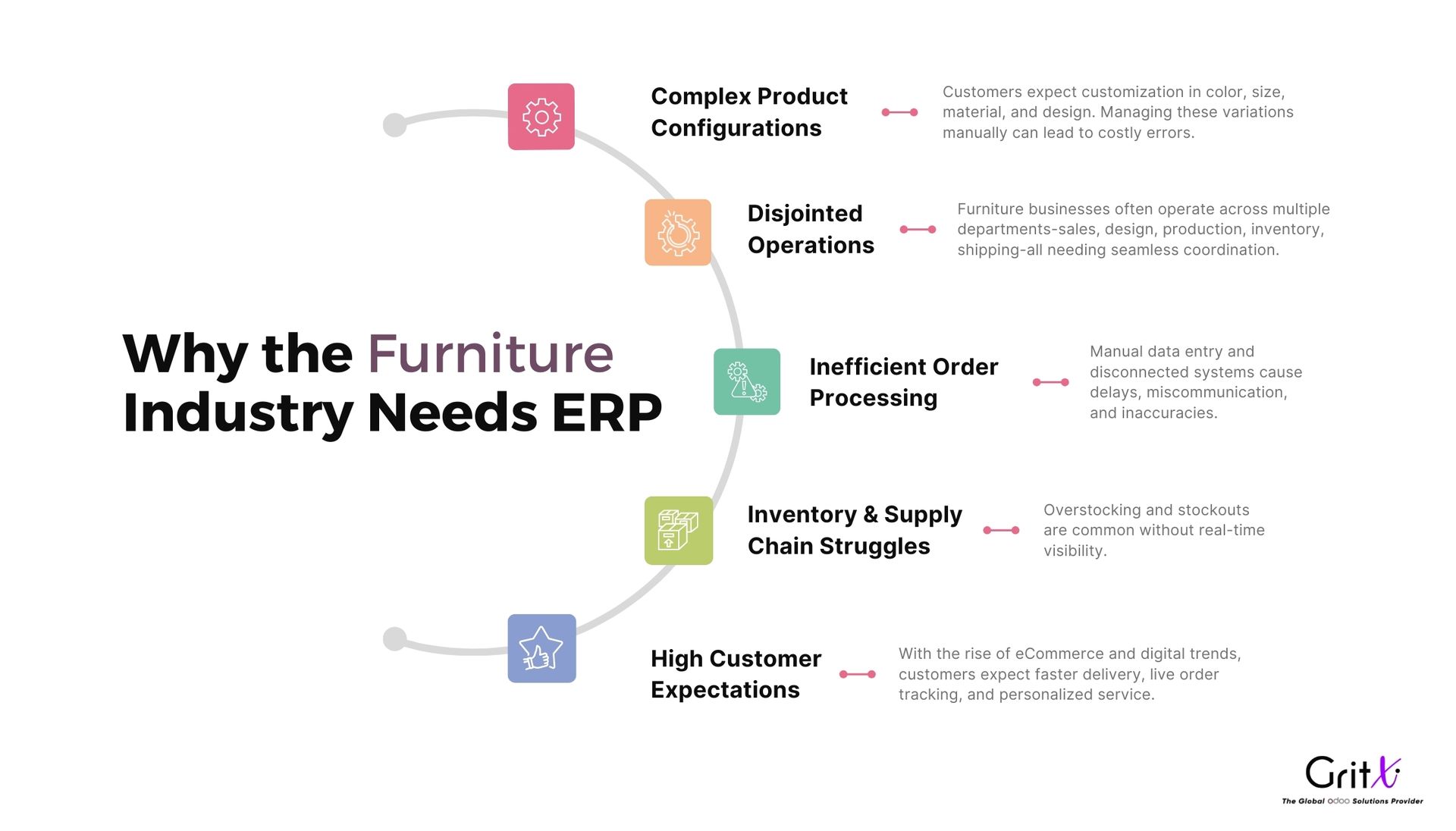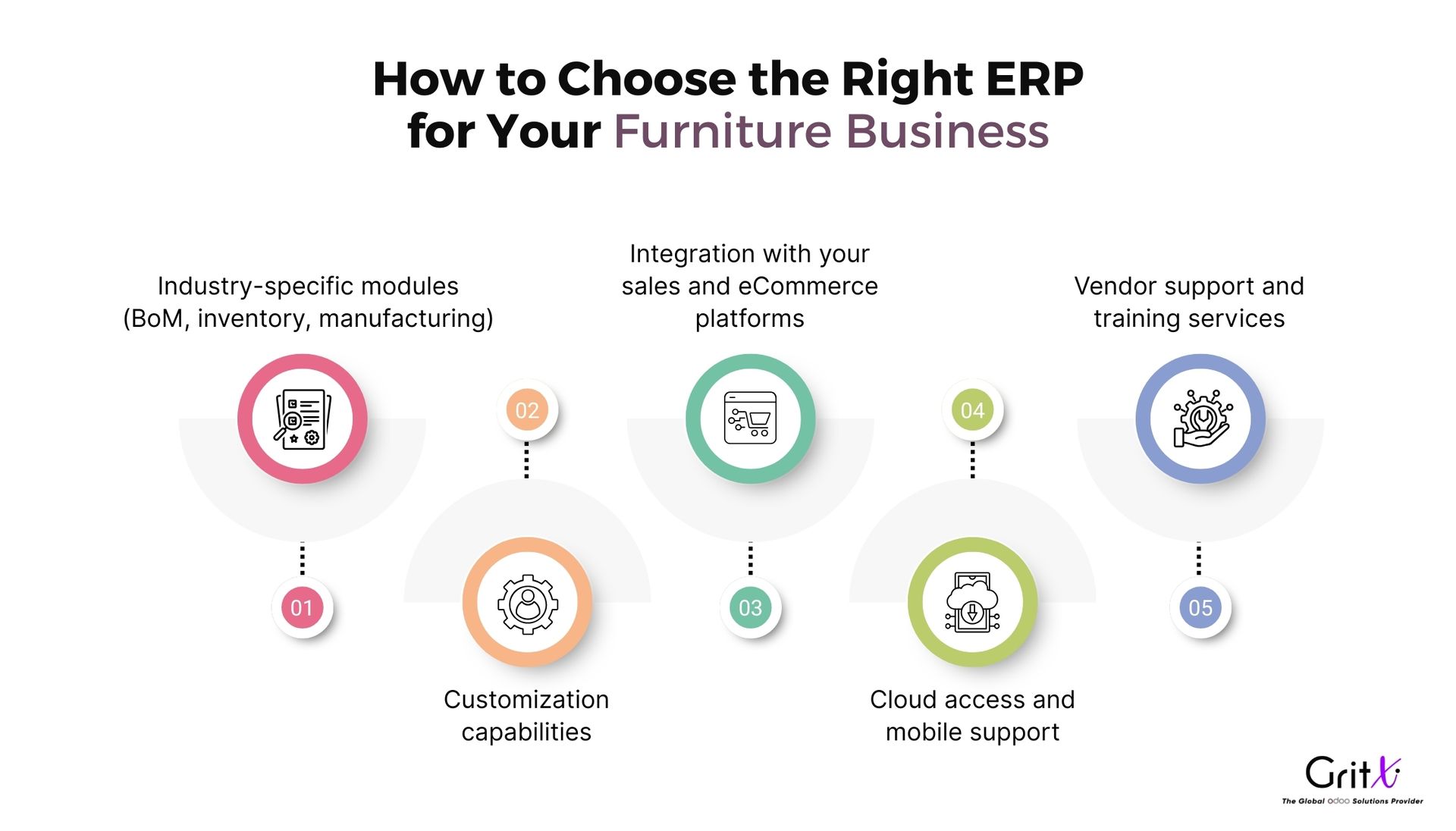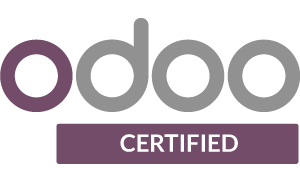In the fast-paced and customization-driven world of furniture manufacturing and retail, businesses need more than just traditional tools to survive—they need technology that can streamline every step from order intake to delivery. This is where ERP (Enterprise Resource Planning) systems play a transformative role. An ERP system tailored for the furniture industry empowers companies to optimize production, manage inventory in real time, deliver on time, and exceed customer expectations.
In this blog, we will explore how ERP solutions revolutionize the furniture industry—from order management to final delivery—and why furniture manufacturers and retailers are increasingly turning to ERP software to gain a competitive edge.

Why the Furniture Industry Needs ERP
The furniture industry faces unique challenges that demand a unified, automated system:
- Complex Product Configurations: Customers expect customization in color, size, material, and design. Managing these variations manually can lead to costly errors.
- Disjointed Operations: Furniture businesses often operate across multiple departments—sales, design, production, inventory, shipping—all needing seamless coordination.
- Inefficient Order Processing: Manual data entry and disconnected systems cause delays, miscommunication, and inaccuracies.
- Inventory & Supply Chain Struggles: Overstocking and stockouts are common without real-time visibility.
- High Customer Expectations: With the rise of eCommerce and digital trends, customers expect faster delivery, live order tracking, and personalized service.
ERP systems help tackle all of these problems with a single integrated solution.
1. Streamlined Order Management
Handling customer orders is one of the most critical tasks for any furniture business. ERP software centralizes all order data—from online storefronts, retail outlets, and sales teams—into one system. This improves efficiency and reduces manual errors.
Key Benefits:
- Automated sales order generation
- Easy tracking of order status
- Handling of customized orders and BoM (Bill of Materials)
- Reduced manual paperwork
For example, if a customer orders a modular sofa with specific fabric and size, the ERP system instantly captures these customizations, generates the necessary BoM, and updates the production team—all in real time.
2. Real-Time Inventory Management
Inventory in the furniture industry involves a mix of raw materials (wood, fabric, foam, etc.), semi-finished goods, and ready-to-deliver products. Without visibility into what's in stock or where it's located, businesses either over-purchase or run into stockouts—both hurting profitability.
An ERP system provides real-time inventory tracking and smart replenishment features.
Key Benefits:
- Centralized inventory data across multiple warehouses
- Automated stock alerts and reorder levels
- FIFO/LIFO stock management
- Integration with barcode/RFID systems
With an ERP in place, you always know your exact stock levels, reducing material wastage and improving purchase planning.
3. Optimized Production Planning
The furniture manufacturing process includes several steps—design, cutting, assembly, upholstery, quality control, and packaging. Managing these phases manually can lead to inefficiencies and production delays.
ERP software automates the entire production cycle with advanced planning and scheduling tools.
Key Benefits:
- Auto-generation of production orders
- Resource and capacity planning
- Production workflow tracking
- Real-time updates on production progress
This ensures your manufacturing process is aligned with order deadlines, avoiding last-minute delays and bottlenecks.
4. Enhanced Supply Chain & Procurement
Furniture businesses often rely on multiple suppliers for wood, metal, upholstery, and accessories. Managing supplier relationships, lead times, and purchase orders is complex—especially without a centralized system.
ERP systems streamline procurement and supply chain operations by integrating supplier data with inventory and production needs.
Key Benefits:
- Supplier performance tracking
- Purchase order automation
- Real-time visibility into incoming materials
- Forecast-based procurement
With accurate procurement planning, businesses can reduce costs, avoid rush orders, and strengthen supplier relationships.
5. Efficient Delivery and Logistics Management
Delivery is the final and most crucial step in the customer experience. Any delays, damages, or miscommunication can tarnish your brand. ERP systems offer built-in logistics and shipping management features that ensure products are delivered efficiently and accurately.
Key Benefits:
- Route optimization and delivery planning
- Integration with third-party logistics providers
- Real-time shipment tracking
- Digital proof of delivery
Customers can receive automated notifications about their order status, boosting satisfaction and reducing post-sale support queries.
6. Improved Customer Relationship Management (CRM)
Modern ERP systems come with integrated CRM features that help furniture businesses offer a more personalized customer experience.
Key Benefits:
- 360-degree customer view
- Sales and support history tracking
- Automated marketing and follow-ups
- Better lead and opportunity management
When sales teams can access customer preferences, past orders, and communication history, they can build stronger relationships and drive repeat business.
7. Better Financial Management and Reporting
Furniture companies often deal with complex pricing, taxes, and cost structures. ERP software simplifies this by offering integrated financial modules.
Key Benefits:
- Accurate cost tracking for each order
- Real-time profit margin analysis
- Automatic invoicing and payment reminders
- Multi-currency and multi-company support
Financial transparency allows business owners to make informed decisions and plan for growth confidently.
8. Data-Driven Insights and Decision Making
One of the hidden powers of ERP systems is the ability to generate actionable insights. Furniture businesses can track KPIs like delivery lead time, production efficiency, inventory turnover, and customer satisfaction.
Key Benefits:
- Customizable dashboards
- Advanced reporting and analytics
- Forecasting and budgeting tools
With ERP-driven insights, furniture brands can optimize processes, reduce waste, and improve customer service continuously.
9. Compliance and Quality Control
ERP systems help ensure quality control and regulatory compliance, especially in international markets with strict furniture safety and environmental guidelines.
Key Benefits:
- Quality checkpoints across production stages
- Standardized inspection processes
- Document control and traceability
- Regulatory compliance (e.g., ISO, FSC)
This reduces the risk of product recalls, penalties, or negative customer experiences.
10. Scalable Growth with Technology
ERP platforms are scalable, meaning your system grows as your business expands—whether you're adding new stores, launching an eCommerce platform, or entering international markets.
You won’t have to keep switching software tools as you grow; instead, the ERP becomes your long-term technology partner.
How to Choose the Right ERP for Your Furniture Business
When selecting an ERP for your furniture business, look for:
- Industry-specific modules (BoM, inventory, manufacturing)
- Customization capabilities
- Integration with your sales and eCommerce platforms
- Cloud access and mobile support
- Vendor support and training services
Popular ERP options for furniture businesses include Odoo, SAP Business One, and Microsoft Dynamics, among others. Odoo, in particular, offers modular, cost-effective, and scalable ERP solutions ideal for SMEs and mid-sized furniture companies.
Conclusion: ERP Is a Game-Changer for Furniture Businesses
From order intake to final delivery, ERP systems optimize every touchpoint in your furniture business. By improving efficiency, reducing costs, and enhancing customer experience, ERP transforms how furniture companies operate and grow.
If you’re still juggling spreadsheets, siloed software, and manual tracking, it’s time to rethink your approach. Investing in a robust, furniture-specific ERP system is not just a technology upgrade—it’s a business transformation.
Need help implementing ERP in your furniture business?
Our expert team can guide you through selecting, customizing, and deploying the right ERP system that fits your workflow and growth goals.





Benefits of ERP for the Furniture Industry: From Order Management to Delivery